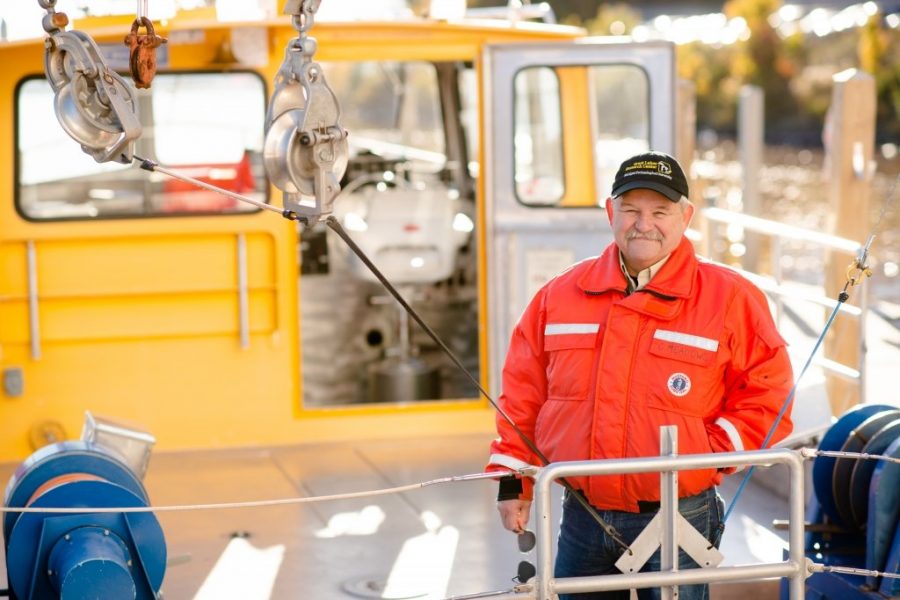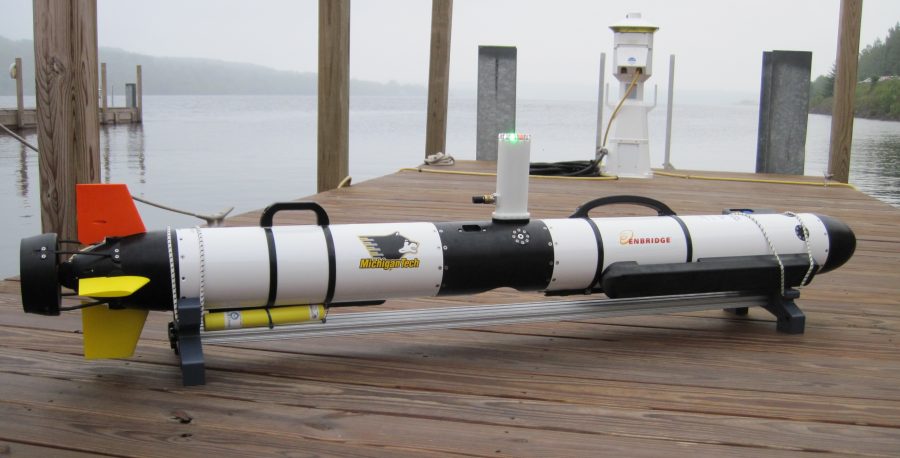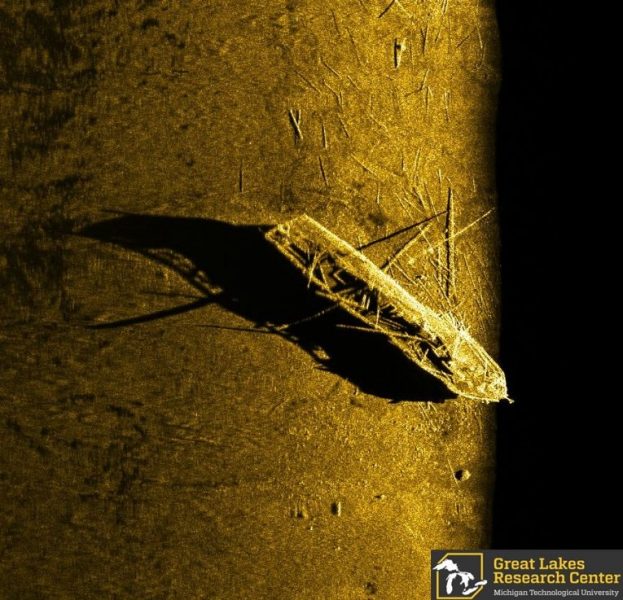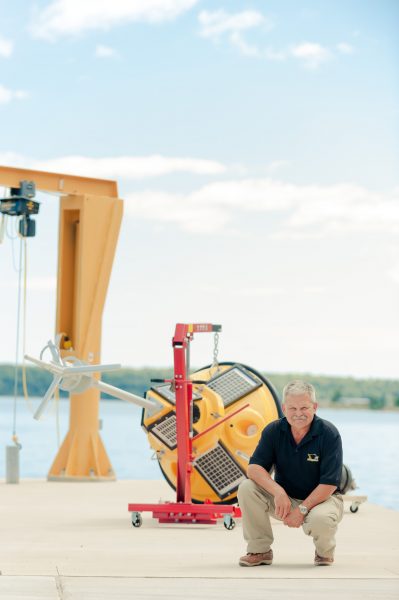
Guy Meadows generously shared his knowledge at Husky Bites, a free, interactive Zoom webinar hosted by Dean Janet Callahan. Here’s the link to watch a recording of his session on YouTube. Get the full scoop, including a listing of all the (60+) sessions at mtu.edu/huskybites.
Guy Meadows uses an underwater robot to chart new territories in the field of underwater exploration. But not just any old robot—one of the world’s best.
Its name is Iver3, and it has two dual processor computers on board, Wifi, GPS, water flow and speed of sound sensors, and the latest in sonar technology. It can dive 330 feet and cover 20-plus miles of water on missions up to 8 hours. It also has a high definition camera, lights and a satellite phone. These combined features make Iver an impressive research tool.

With Iver, Meadows and his team are able to provide ultra-high resolution acoustic images underneath the waters of the Great Lakes. “Whether it’s tracking underwater features, looking at shipwrecks, or mapping trout spawning beds, we can do this all much more precisely and in much greater detail than was ever possible,” he says.
Meadows is director of the Marine Engineering Laboratory, and the Robbins Professor of Sustainable Marine Engineering at Michigan Tech. His work with Iver is cutting edge. “Iver can obtain a ‘survey quality’ map of a swath of the bottom of Lake Superior,” he explains. “The map size depends on the altitude of the robot above the lake floor, but at ten meters above the bottom you can map an entire football field.”
“What we’re doing is seeing with sound waves. Acoustic energy shines on the target and illuminates it for us. Navy research vessels use active remote sensing, too,” he adds. “But we can see a lot more clearly with Iver.”

Michigan Tech students learn how to program Iver as part of their many classes onboard Agassiz, the university’s research vessel. “If we set up the geometry just right, we can get the highest possible quality sonar image,” Meadows explains.
“When we go out to look at shipwrecks in Lake Superior, we program Iver to fly a prescribed distance from the bottom of the lake, and a prescribed distance from the vessel. We can see both the image of the target vessel, and its acoustic shadow,” says Meadows. “The images are fantastic, but the shadows also provide a great deal of valuable information and detail.”
Q: When did you first get into engineering? What sparked your interest?
“I was born and raised in the City of Detroit. I went to Detroit Public Schools, and when I went to college I had to work to make ends meet. I got a job as a cook in the dorm, and and eventually worked my way up to lead cook. I was cooking breakfast for 1,200 people each morning. One of my fellow classmates was studying engineering, too. He had a job working for a professor doing research on storm waves and beaches. I had no idea I could be hired by a professor and get paid money to work on the beach! I quit my job in the kitchen soon after, and went to work for that professor instead. I had been a competitive swimmer in high school, and the beach was where I really wanted to be. When I graduated with my degree, having grown up in Detroit, I went to work for Ford. I have to thank my first boss for assigning me to work on rear axle shafts. After about two months, I called my former professor, to see if I could come back to college.
My advice for students just starting out is to spend your first year exploring all your options. Find out what you really want to do. I had no idea I could turn a mechanical engineering degree into a job working on the beach. Turns out, I could—and I’m still doing it today.
Q: What do you like to do when you’re not on the beach or out on the water?
Having grown up in Detroit, I have had the opportunity to live, work and grow in a very diverse community. While as a faculty member at the University of Michigan, I was part of a great team that started the M-STEM Academies and became its founding director. The M-STEM mission is “to strengthen and diversify the cohort of students who receive their baccalaureate degrees in science, technology, engineering, and mathematics (STEM), with the ultimate goal of increasing the number and diversity of students who are well prepared to seek career opportunities or to pursue graduate or professional training in the STEM disciplines in the new global economy.” This effort has been a very important part of my journey.
More about Guy Meadows
Throughout his career Guy Meadows has influenced policy and explored societal impacts of environmental forecasting for coastal management, recreational health and safety, and regional climate change.

After graduation from Purdue University with PhD in Marine Science in 1977, he joined the faculty of the University of Michigan College of Engineering, where he served as professor of physical oceanography for 35 years. During that time, Meadows served as director of the Ocean Engineering Laboratory, director of the Cooperative Institute for Limnology and Ecosystems Research (NOAA, Joint Institute), director of the Marine Hydrodynamics Laboratories.
Meadows joined Michigan Tech in June of 2012, to help establish the new Great Lakes Research Center. His primary goal is to blend scientific understanding and technological advancements into environmentally sound engineering solutions for the marine environment, through teaching, research and service.
His research focuses on geophysical fluid dynamics, with an emphasis on environmental forecasting, full-scale Great Lakes and coastal ocean experimental hydrodynamics.
His teaching reaches beyond the University to less formal settings and includes five nationally televised documentaries for the History and Discovery Channels.
Read & View More
Huskies Help Solve Sunken Minesweeper Mystery
Subsurface Vehicles at Michigan Tech’s Great Lakes Research Center‘
Be Brief: Shipwreck
Freshwater Flights Reveal What Lies Beneath
